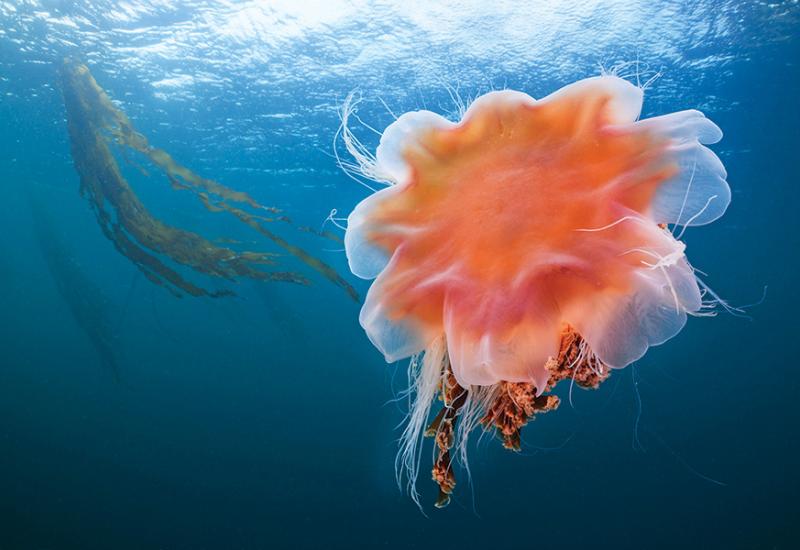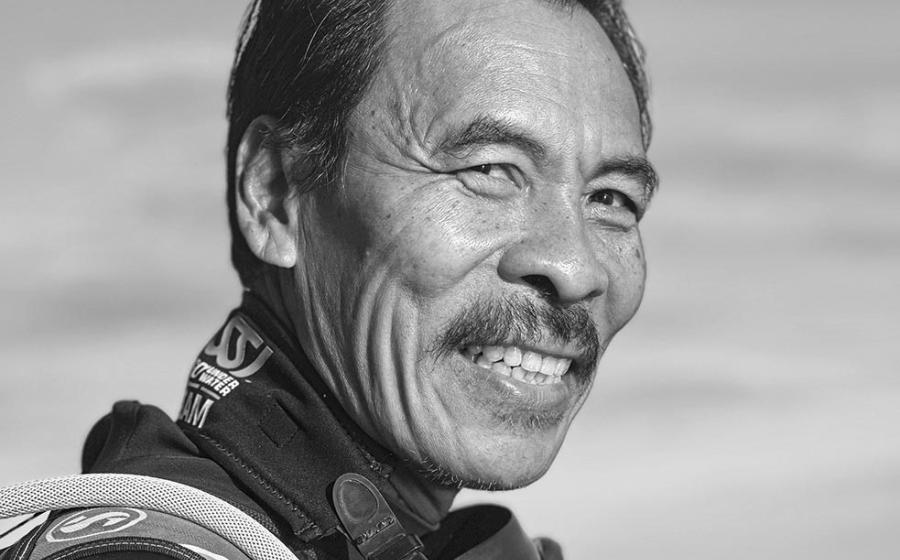Bula to the Rainbow: Scuba Diving Fiji's Taveuni Island

Brandon ColeMelissa Cole peers through a sea fan.
I created my playbook early on in life. Borrowing more than a few pages from my hero’s logbook, my mission was to follow in Jacques-Yves Cousteau’s finkicks. Where he dived, so must I. He branded Fiji as the “soft coral capital of the world,” so I would go and see it for myself. Simple as that.
My first trip to this South Pacific nation of warm “Bula!” greetings, wide, dazzling smiles, and bustling, resplendent reefs was to Taveuni Island to dive the Rainbow Reef. Its name certainly did paint a vivid picture. Add the glowing endorsement of the legendary red-capped explorer and I fully expected—rain or shine—to experience full-spectrum chromatic overload courtesy of the soft corals. I did. Thoroughly wowed, I vowed to come back.
Decades later I returned to the same hearty “Bula!” welcomes of the Fijian people. In their language, bula means many things: hello, welcome, and even love. This time my wife Melissa was with me for the week adrift in bliss below the waves in the very same Somosomo Strait, the current-swept passage between Taveuni and larger Vanua Levu islands.
Somosomo translates into “good water.” That’s an understatement. Swift tidal currents act as a conveyor belt, moving nutrients and planktonic protein back and forth to the many waiting fish mouths, hard coral polyps, and sticky, spiky, spectacular soft corals. Hundreds of other species from sea slugs to sea snakes and morays to manta rays also thrive in these much-better-than-merely-good waters. Staying at the Garden Island Resort on Taveuni, we made daily two and three tank forays out to the Rainbow Reef complex. Our boat, the Rainbow Reef Diver, was a sturdy, fast, 30-foot-long aluminum craft that whisked us to and from a dozen of the 25-some dive sites less than 20 minutes from the dock. There is way more on offer than we could see in just one week.

Brandon ColeJerry's Jelly dive site in Somosomo Strait showcases colorful soft corals, sea fans, sponges and frantic fish, including scalefin anthias.
One of our top favorites was Jerry’s Jelly with a huge mound of coral my better half described as an overgrown hobbit house. I thought it looked more like a giant’s head, mostly bald on top at about 25 feet but with a power doughnut fringe of lovely soft corals around the bottom edge. Schooling snappers and fusiliers and a few barracuda orbited above the lumpy bommie. My photographic focus, however, was primarily on the curtain of icy lavender soft corals hanging underneath and the seafans, crinoids, whips, sponges, soldierfish, damsels and more marine life forms choking the shadowy pace below the ledge and the see-thru window (too small to swim through) in the formation’s base. Absolutely totoka (beautiful, pretty).

Brandon ColeMelissa Cole relaxes in between dives on the Rainbow Reef Diver between the Taveuni and Vanua Levu Islands.
When I begged to do this site again later in the week, we played in the jelly for a few moments and then cruised reef right along to Blue Ribbon Eel Reef. This combination made a great twofer submersion, but photographers will want to have both wide and macro rigs as the subject matter is all over the map. Vinaka vaka levu (thank you very much) to mermaid sherpa Melissa for her help in this regard. After shooting the bommie at Jerry’s with my 15mm fisheye setup, I switched to the narrow 100mm optic for portraits of leaf scorpionfishes and the namesake blue ribbon eels. Our eagle-eyed guide Leo found three of the former between 25 and 35 feet deep. A white leafy was perched in a thicket of staghorn coral, a yellowy-greeny-orangey patterned one camouflaged amongst cauliflower corals, and finally a maroon specimen. We also scored in the blue ribbon eel department, spotting three of the fierce, electric-blue devils with flared golden nostrils in the rubble down at 45 feet. The palette surgeonfish (aka Dory of Nemo movie fame) up in the shallows was an unexpected surprise. I was learning that there’s more to the Rainbow Reef than just the signature soft corals.
Current calls the shots in Somosomo Strait. The strength and direction of the water flooding and ebbing through the maze of reefs determines when and where you can dive safely and comfortably. Low slack—basically the very end of the outgoing tide—is ideal for the Great White Wall. It is not diveable every day, so if you want to see one of Fiji’s most celebrated sites be sure to consult with your resort’s dive team before choosing dates for your stay. There is a cool tunnel boring down and through the reef which then exits at 70 feet on the sheer wall plunging to over 200, a dramatic wall plastered with soft corals. From a distance they appear glacial white, but up close you realize that most are actually an enchanting, pale pink-purple in hue. We found the sweet spot for eye candy to be in the 90-to-100-foot range, where red and orange encrusting sponges contrast brilliantly with the exquisite soft corals. Dogtooth tuna are occasionally seen off the wall out in the blue and between the months of March and September manta rays have been known to swoop past in all their majesty. This site, and the adjacent Great Purple Wall, are classified by most as advanced dives.

Brandon ColeMelissa Cole swims ninety feet down along the Great White Wall in the Rainbow Reef region of the Somosomo strait.
Legend has it that Cousteau spent many an hour at Annie’s Bommie. We dived the site twice, and would have done more had we more time. The reef positively thrummed with energy. Clouds of orange scalefin anthias, also called fairy basslets, vibrated in the current while feeding above a wonderful mosaic of hard and soft corals. Weaving through elegantly arcing clusters of sea whips and fuzzy clumps of gorgonians were surgeonfish, goatfish, bannerfish and a half dozen species of angelfish. I was particularly hard pressed to choose between stalking the many male blackspot angels with bold zebra striping and the threespot angelfish proudly sporting blue lips and a canary yellow body. Truth be told, I had trouble doing anything constructive with my camera. It was just too much fun to stare wide-eyed at the big picture and let all the somosomo soak in through visual osmosis.
On a few trips, the last tank has ended up being a bit underwhelming. Perhaps I was simply too distracted underwater, what with all the impending rush to rinse gear and start packing. But I most definitely did not want to get out of the water at Rainbow’s End for our Fiji finale. I was NOT daydreaming about my landlocked life somewhere over in that other hemisphere. On that day, I was in the moment, wishing for more of them.

Brandon ColeThe author encounters an adult ribbon eel approximately two feet long. Blue males eventually change sex, becoming yellow females.
When the current is just right, this site is a stellar drift through Taveuni’s undersea kaleidoscope. Artful fireworks explosions of rainbowed cotton candy, the soft corals sprouted from bommie crests and cascaded from table corals. They ringed seafans like exotic flowers around the base of ornamental trees. The reef was painted in the glory of a Crayola gigapack. A green turtle sculled by. Lionfish strutted around with fin spines flared. Predatory jacks hunted smaller fish with lightning speed. Anemonefish, angels, butterflies, coral groupers, parrots, snappers. A napoleon wrasse, a titan trigger, a family of anemonefish. And everywhere, orange and purple anthias rained down on us.
Back on the boat, our guide’s spirited proclamation summed things up perfectly. “The soft corals were really blooming today!”
Melissa excitedly chimed in, “Soft coral palooza!”
My mind still below the waterline, my spirit still soaring in that nirvana, it took me a while to add, “Bula to the Rainbow.”










